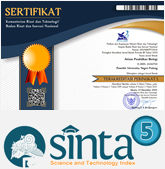An Analysis of High Order Thinking Skills Aspects on the Assessment Instruments in Animalia Topic for the 10th Grade Senior High School Students
Abstract
This research was carried by descriptive research method that analyzed the assessment instruments used by teachers in schools and analyzed students’ high order thinking skills in ‘Animalia’ material. High order thinking skills is the ability to manipulate information or received ideas and apply it to solve a problem. This research was conducted in Senior High School 8 Padang. The assessment instruments used to collect the data was test which require high order thinking skills in ‘Animalia’ material that had been validated by one of lecturers in the department of Biology. The test amounted 50 items consisting of 30 common multiple choice questions, 10 causal multiple choice questions, and 10 association multiple choice questions that are at the C4-C6 cognitive level. The results showed that the assessment instruments made by the teacher were still at the C1-C3 cognitive level. It is concluded from the daily test questions about ‘Plantae’ material with percentage of C1 by 13.3%, C2 by 50%, and C3 by 16.7% that did not meet the aspects of high order thinking. After testing high order thinking questions about ‘Animalia’ material, it indicated that students' high order thinking skills was still in low grade with a class average of 24.37. The strategy that can be used to improve students' high order thinking skills is to familiarize students with working on questions that require high order thinking skills.
Keywords
Full Text:
FullpaperReferences
Heong, Y. M. 2010. “The Level Of Marzano Higher Order Thingking Skills Among Technical Education Students”. International Journal Of Social and Humanity Vol. 1, No. 2: 121-125.
Istiyono, E, mardapi, j, suparno. 2014. Pengembangan tes kemampuan berpikir tingkat tinggi fisika (pysTHOTS) Peserta didik SMA. Jurnal penelitian dan evaluasi pendidikan
Kunandar. 2015. Penilaian Autentik: Penilaian Hasil Belajar Peserta Didik Berdasarkan Kurikulum 2013. Jakarta: Raja Grafindo Persada.
OECD. 2016. Country Note Result from PISA 2015 (online) (https://www.bps.go.id/-linkTableDinamis/view/id/1054. diakses tanggal 4 Februari 2019)
Permendikbud Nomor 22. 2016. Standar Proses Pendidikan Dasar dan Menengah. Tentang Kurikulum 2013.
Rahmawati. 2016. Seminar Hasil TIMSS 2015 (artikel, diakses tanggal 4 Februari 2018).
Rosnawati, R. 2012. Enam Tahapan Aktifitas Dalam Pembelajaran Matematika Untuk Memberdayagunakan Berpikir Tingkat Tinggi Siswa(Makalah). Diambil Tanggal 4 Februari 2018 dari http://staff.uny.ac.id.
Sani, R. A. 2016. Penilaian Autentik. Jakarta: Bumi Aksara.
Sunarti dan Rahmawati. 2014. Penilaian Dalam Kurikulum 2013: Membantu Guru dan Calon Guru Mengetahui Langkah-Langkah Penilaian Pembelajaran. Yogyakarta: Andi Offset
Uno, H.B. dan Koni S. 2012. Asesmen pembelajaran. Jakarta: Bumi Aksara.
DOI: http://dx.doi.org/10.24036/apb.v4i4.6901
DOI (Fullpaper): http://dx.doi.org/10.24036/apb.v4i4.6901.g3614




